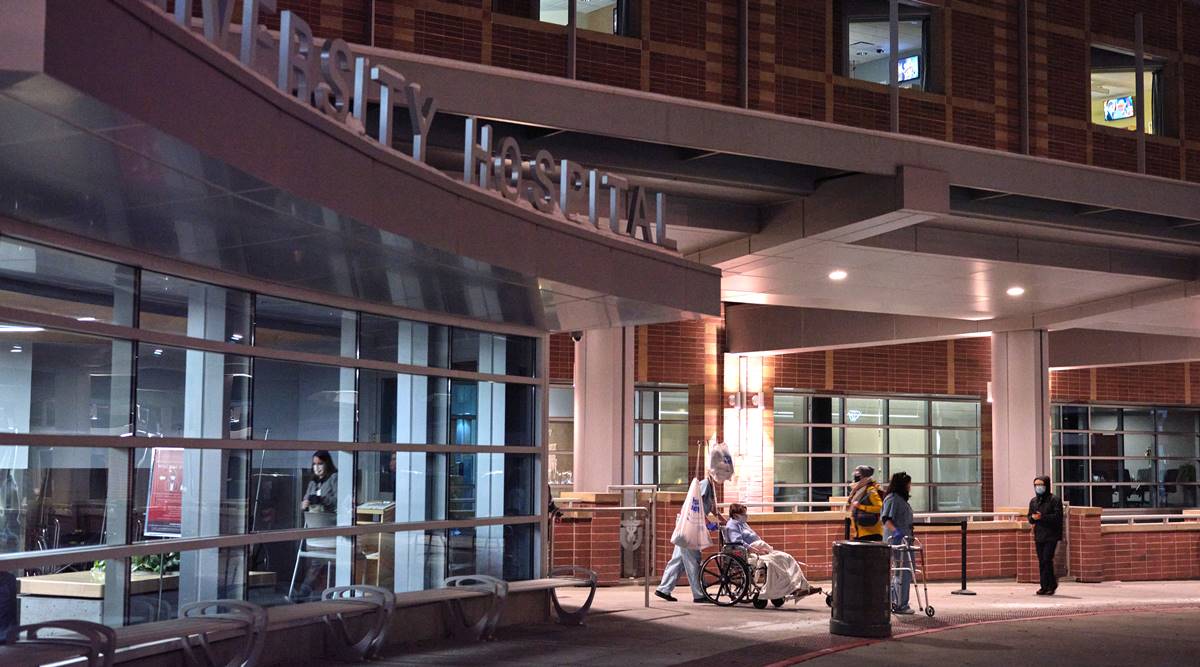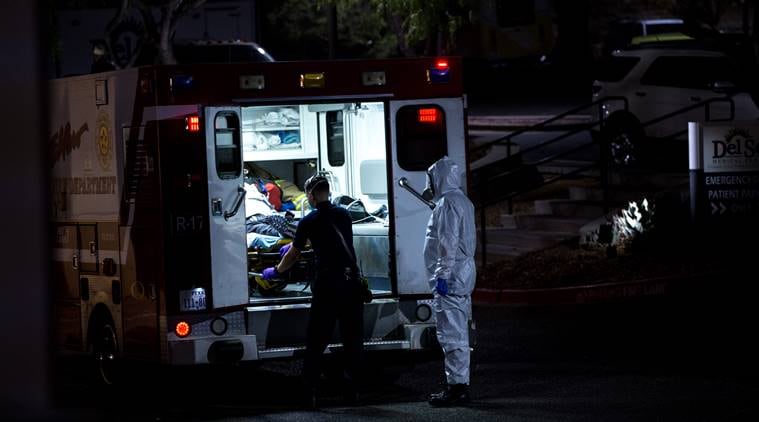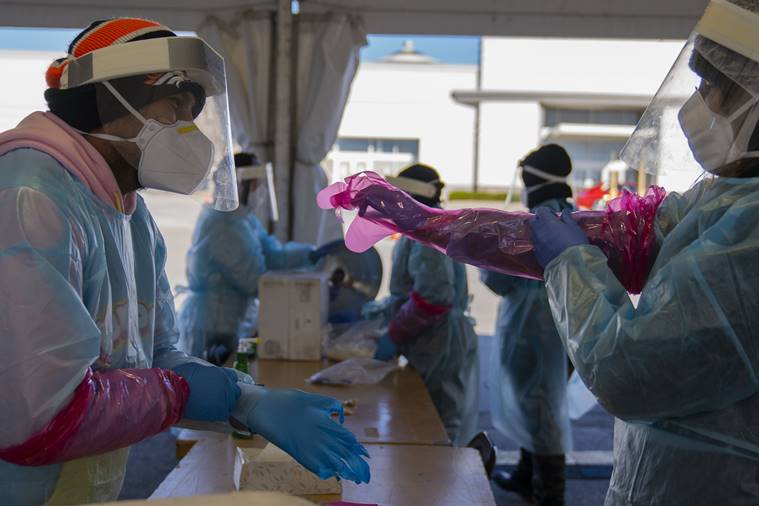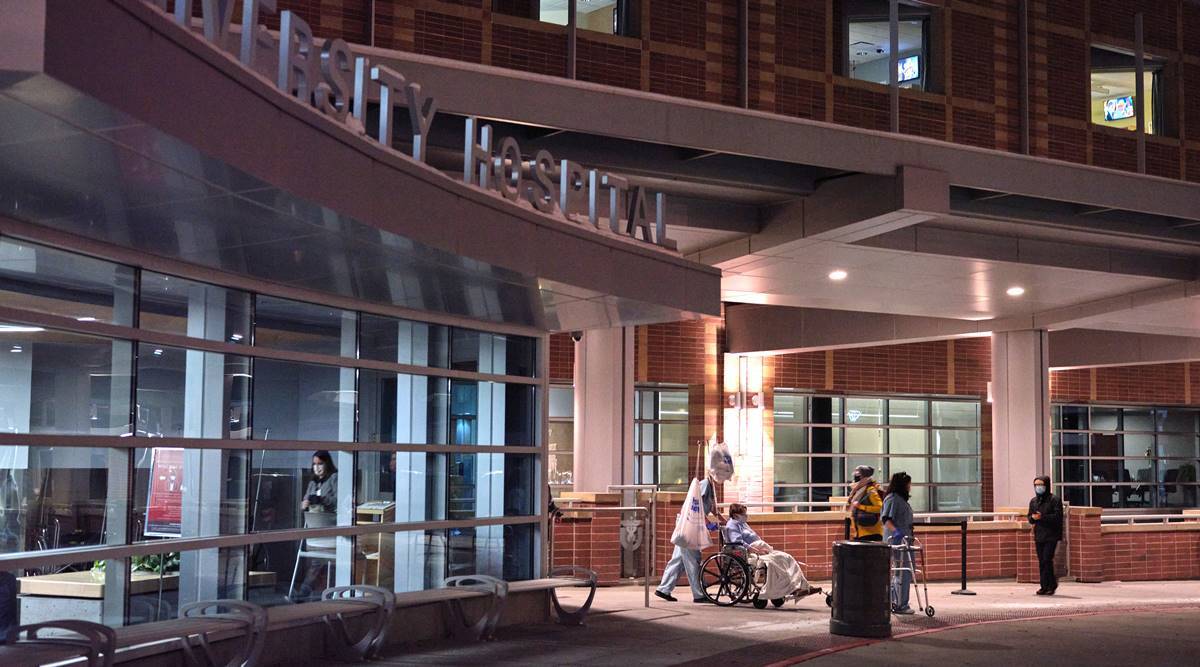[ad_1]
 Shift adjustments at The University of Utah Hospital throughout a nationwide spike in coronavirus circumstances, Salt Lake City, Nov. 10, 2020. (Lindsay DÕAddato/The New York Times)
Shift adjustments at The University of Utah Hospital throughout a nationwide spike in coronavirus circumstances, Salt Lake City, Nov. 10, 2020. (Lindsay DÕAddato/The New York Times)
Written by Sarah Mervosh, J. David Goodman and Julie Bosman
By the time that Doug Raysby’s spouse was allowed to enter his hospital room, it was too late to make certain whether or not he even knew she was there. After a feverish combat with the coronavirus, he lay unconscious on the mattress. His spouse cried via an N95 masks, whereas a pc pill flashed a video stream of his youngsters saying goodbye.
For weeks, as coronavirus circumstances spiked throughout the United States, deaths rose way more slowly, staying considerably decrease than in the early, deadliest weeks of the nation’s outbreak in the spring. New therapies, many hoped, may gradual a brand new wave of funerals.
But now, indicators are shifting: More than 1,000 Americans are dying of the coronavirus day by day on common, a 50% enhance in the previous month. Iowa, Minnesota, New Mexico, Tennessee and Wisconsin have recorded extra deaths over the previous seven days than in every other week of the pandemic. Twice this previous week, there have been greater than 1,400 deaths reported in a single day.
“It’s getting bad, and it’s potentially going to get a lot worse,” mentioned Jennifer Nuzzo, a public well being researcher and senior scholar on the Johns Hopkins Center for Health Security. “The months ahead are looking quite horrifying.”
For households like Raysby’s, the ache of private loss has mixed with a way of anger that the nation, exhausted after 9 months of the pandemic, has grown inured to the demise toll, whilst its tempo is quickening once extra.
“Do you see this human being? Do you realize?” mentioned Kathy James, the mother-in-law of Raysby, a 57-year-old manufacturing unit supervisor in Sioux Falls, South Dakota, who appreciated to hunt pheasants on the weekends.
In the weeks since Raysby died of the virus, James mentioned she had needed to wave a photograph of him — a quiet, bespectacled man who once wooed her daughter with purple roses — on the world.
“Do you see Doug?” she mentioned. “Because he should be alive and he should be with us right now.”
 Medical employees transport a affected person at Del Sol Medical Center in El Paso, Texas (Joel Angel Juarez/The New York Times)
Medical employees transport a affected person at Del Sol Medical Center in El Paso, Texas (Joel Angel Juarez/The New York Times)
More than 244,000 folks have died from the coronavirus in the United States, greater than every other nation, and consultants say the tempo of latest deaths is prone to speed up in the approaching weeks.
Deaths lag a number of weeks behind infections, so the toll being recorded now displays transmission that occurred a number of weeks in the past, earlier than the nation started logging greater than 140,000 new circumstances per day and hospitalizations reached their highest ranges of the pandemic. On Friday, public well being officers reported greater than 181,000 new circumstances throughout the nation, greater than ever earlier than.
The nation stays far under the demise toll of the spring, when as many as 2,200 folks have been perishing every day, however some estimates counsel that the United States might quickly be on monitor to achieve and even exceed these ranges.
From the Midwest to the Sun Belt, officers are bracing for a mounting demise toll.
In Marathon County, Wisconsin, a sprawling neighborhood in the grip of a COVID-19 surge, a refrigerated morgue truck is now cooled and prepared in case it’s wanted. The health worker’s workplace has stocked additional physique luggage. A smaller, walk-in cooler was additionally introduced in.
Two hours southeast, in Fond du Lac County, Wisconsin, Dr. Adam Covach, the chief health worker, mentioned the system had been strained by the uptick in deaths. Funeral properties are exceedingly busy. Covach has checked out his personal storage capability and questioned: How quickly may his workplace be overwhelmed?
“If things continue increasing at the rate they’re going, it’s going to start getting pretty scary pretty fast,” he mentioned.
 Medical employees sanitize themselves earlier than testing for the coronavirus at a mall in Omaha, Neb. (Calla Kessler/The New York Times)
Medical employees sanitize themselves earlier than testing for the coronavirus at a mall in Omaha, Neb. (Calla Kessler/The New York Times)
In El Paso, Texas, there have been so many coronavirus deaths in latest days that the county health worker parked 5 cell morgue items — the scale of vans — outdoors its doorways. Legacy Mortuary Service, an organization that transports our bodies from hospitals to funeral properties, is busier than ever, carrying 40 to 50 our bodies most days now, its proprietor, Pilar Contreras, mentioned.
German Alvarado mentioned he needed to wait practically two weeks to carry a funeral for his father-in-law, Antonio Sierra Macias, a mechanic who died of the virus.
Alvarado mentioned his spouse and three youngsters youthful than 12 first confirmed signs, then he bought it, too. By mid-October, Sierra Macias additionally fell sick and was admitted to a hospital, the place he realized he had diabetes, in addition to hypertension.
Things gave the impression to be enhancing, however Sierra Macias took a flip for the more serious. He was 49.
Alvarado mentioned it was troublesome to cope with such loss whilst folks round him appeared to not be taking the virus significantly, believing it was being overhyped or pondering, by some means, that it was not harmful.
“It seems like people think the news are overthinking, overtalking,” mentioned Alvarado, who mentioned he was ready for paperwork to ship his father-in-law’s physique for burial in Ciudad Juárez, Mexico, the place cemeteries are working out of room. “You don’t realize the situation until you live through it.”
The rising case numbers — and the specter of mounting deaths — have led some consultants to name for a coordinated nationwide shutdown for 4 to 6 weeks. Other consultants have advocated for a mix of masks, elevated testing, paid assist for folks in quarantine and focused shutdowns centered on high-risk indoor areas as a technique to gradual the toll.
 Mobile Morgue trailers for coronavirus victims parked close to a cemetery in El Paso, Texas. (Joel Angel Juarez/The New York Times)
Mobile Morgue trailers for coronavirus victims parked close to a cemetery in El Paso, Texas. (Joel Angel Juarez/The New York Times)
“We can expect the case and death count to continue to rise exponentially unless we take serious measures to mitigate the virus,” mentioned Dr. Howard Markel, a historian of epidemics on the University of Michigan. “All of this is terrible news.”
But with no bulletins from the White House for brand new measures to reply to the outbreak, many of the nation is open for enterprise, whilst a couple of governors started calling for brand new restrictions Friday.
Gov. Michelle Lujan Grisham of New Mexico issued probably the most sweeping statewide mandate this fall, returning to a “stay at home” order Monday that can final two weeks. In Oregon, Gov. Kate Brown plans to place the state in a partial lockdown for 2 weeks beginning Wednesday, shuttering gyms, halting restaurant eating and mandating that social gatherings have not more than six folks.
A visibly indignant Gov. Mark Gordon of Wyoming, talking at a information convention, mentioned that hospitals have arrange tents as a result of they are overrun, that sufferers from crowded services in South Dakota have been despatched into Wyoming, and that misinformation in regards to the virus was working rampant. He mentioned he was contemplating a masks mandate and different restrictions after months of hesitation. People in Wyoming have been “knuckleheads” in regards to the virus, he mentioned.
“We’ve relied on people to be responsible and they’re being irresponsible,” Gordon mentioned. “If I can’t rely on you, we’re going to have to do something else.”
[ad_2]
Source hyperlink











